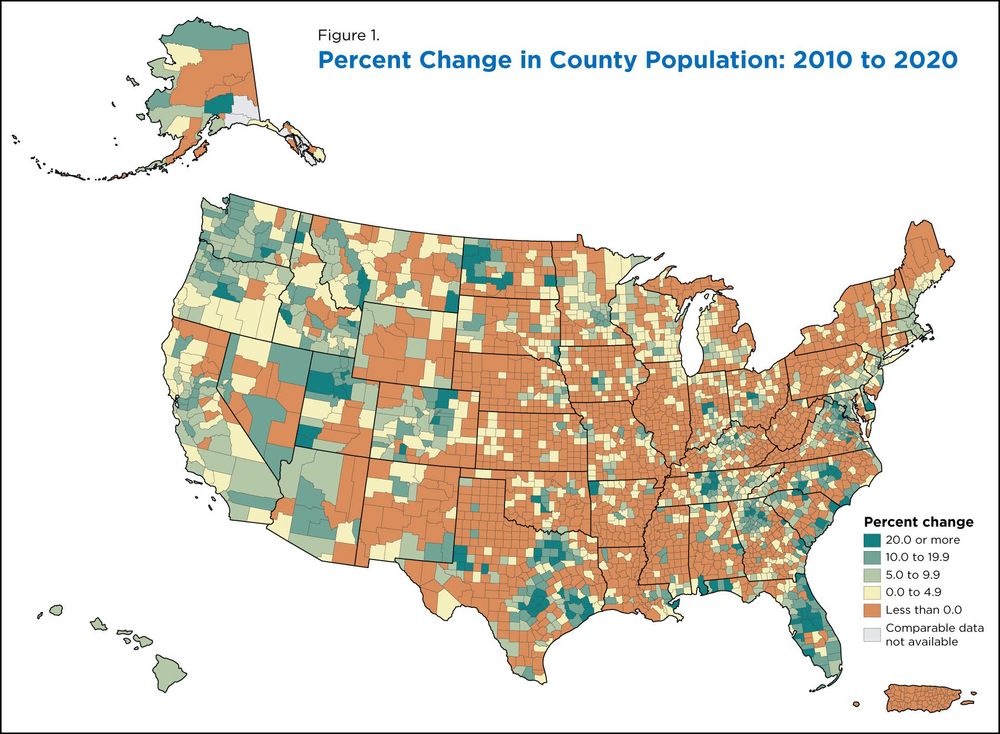The 2020 Census data is in, with both encouraging and disconcerting results.
First, the good news.
The country has gotten more diverse.
According to Nicholas Jones, the Census Bureau’s Population Division director of race, ethnicity, research and outreach:
“These changes reveal that the U.S. population is much more multiracial, and more racially and ethnically diverse, than what we measured in the past.”
In the past ten years, Asian and Latinx populations have exploded while the Caucasian population has declined to under 60% for the first time on record.
Most of the population has also moved into the cities.
52% of rural counties with under 10,000 people experienced a 2.8% decline while metropolitan areas grew by 8.7%.

The Asian-American population showed the fastest growing demographic by 35%; the Hispanic population is second with 23%; the African American population, 5.6%.
As Salon reported:
“Nearly half of all children in the country are nonwhite. The number of people reporting two or more races or ‘other race’ also significantly increased, suggesting that some of the trends may be the result of changes to how respondents self-identify.”
If we think republicans are going to take the demographic shift lying down, we’re kidding ourselves.
In addition to seeing their gerrymandered political shell game under threat, they fear their white “replacement” theory might be coming to fruition.
Author and progressive radio show host Thom Hartmann wrote this week:
“They’re frightened by the new census data showing that whites are a decreasing majority in America, and terrified by the prospect that Afghans who risked their lives for America might move here.”
That brings us to the bad news.
Article one, section two of the Constitution explains:
“Representatives and direct Taxes shall be apportioned among the several States which may be included within this Union, according to their respective Numbers, which shall be determined by adding to the whole Number of free Persons, including those bound to Service for a Term of Years and excluding Indians not taxed, three fifths of all other Persons.”
The racist “three-fifths compromise” and complete ignoring of Native Americans aside, the decennial census helps determine congressional representation and apportionment of taxes and resources.
Lower numbers means fewer representatives in the House, which means fewer allocated funds for federal infrastructure projects, which is exactly why the republican party is gearing up to make sure these demographic shifts do not affect the gerrymandered districts they control despite voters overwhelming voting Democratic.
Republicans know most Americans find republican policies odious, so in order to win, they cheat through voter I.D. laws, voter suppression, and plain old policies designed to do one thing–rig the system in their favor.
Josh Silver, heads of the nonpartisan reform group “RepresentUs,” recently told The Nation:
“States have long been preparing for this moment, and they now have the green light to start gerrymandering. If left unchecked, this year’s redistricting cycle represents a severe threat to our democracy. Gerrymandering is one of the worst forms of political corruption, and leads to extremism and partisan gridlock. The maps drawn this year will shape American politics and policy for the next decade.”
Despite more people voting for Democrats, gerrymandering has handed republicans 187 congressional districts and absolute authority over 20 states’ redistricting processes.
Democrats, on the other hand, control just 84 districts and 11 states’ redistricting processes.
Some states, like New York, have independent redistricting commissions or split governments, which some are arguing may work in Democrats’ favor.
Dave Wasserman says Democrats in New York may use the new Census data to get rid of 5 House Republican districts in the state. pic.twitter.com/a6ZfkOmIrk
— Sarah Reese Jones (@PoliticusSarah) August 13, 2021
After the last census showed similar diversity trends and Democrats started winning more elections, gerrymandering allowed republicans to maintain decade-long majorities in several congressional delegations and state legislatures.
The fact that populations in metropolitan areas grew by 8.7% might actually make republican redistricting efforts easier.
Michigan State University Institute for Public Policy and Social Research director, Matt Grossmann, explained:
“Even if you’re not trying to gerrymander on behalf of Republicans, the fact that Democrats are concentrated in cities and in the inner-ring suburbs means that it is easier to accidentally gerrymander on behalf of Republicans.”
Democrats may also have missed a shot at blocking state-level republicans from monopolizing the redistricting process.
As recently published in The Daily Poster:
“Just before the Senate adjourned for its August recess, Republicans blocked an effort by Senate Majority Leader Chuck Schumer, D-N.Y., to get the chamber to consider pared-down versions of the party’s voting rights and democracy reform legislation. Schumer’s ploy was largely symbolic: It was doomed to failure, given the lack of any GOP support, because Senate Democrats have so far refused to eliminate the filibuster and therefore need ten Republican votes to pass most legislation.”
That filibuster is preventing the passage of SB 1, the Senate version of House Resolution (HR)1, the “For the People Act,” which “expands Americans’ access to the ballot box, reduces the influence of big money in politics, strengthens ethics rules for public servants, and implements other anti-corruption measures for the purpose of fortifying our democracy, and for other purposes.”
Re-introduced in January, HR1 passed 220-210 on March 3 with no Republican support and only one Democrat opposing.
HR1/S.1 seeks, in part, to:
- Include providing voters access to automatic and same-day registration
- Fully restore the Voting Rights Act
- Allow a two-week early- voting window that includes evenings and weekends
- Create a small-donor matching system that provides qualified presidential and congressional candidates $6 in public funds for every $1 raised from small donors
- Close federal campaign disclosure rule loopholes
- Curtail foreign funds in U.S. elections
- Address issues at the Federal Election Commission (FEC)
- Guarantee states use independent redistricting commissions when drawing congressional districts whose members represent diverse communities
- Establish fair redistricting standards and mandate better transparency in the redistricting process
- Require states replace paperless voting machines
- Offer new grants to enhance election security
- Develop more effective systems for auditing disputed elections
- Implement new security requirements for election system vendors that includes a mandate to report cybersecurity breaches.
A full breakdown of its sweeping provisions can be found here.
If passed, it would all but negate hundreds of bills republican-majority state legislatures are passing to restrict voting, criminalize peaceful protest, revoke authority from state courts and local election boards, and discard votes that aren’t for them.
In March, Georgia Gov. Brian Kemp signed legislation to strip election control from local and county election boards in order to impose new voter ID requirements, limit mail-in ballot drop boxes, reject entire ballots erroneously misdelivered to incorrect precincts, allow conservative activists to challenge voters’ eligibility, even criminalize distributing pizza and water to voters waiting in line for their turn to cast their ballots.
Then Fla. Gov. Ron DeSantis followed suit.
Other restrictive bills have been signed in Iowa, Arkansas, and Utah.
Arizona republican state senators are behind a recount of 2020 presidential election ballots because the entire party they serve has doubled down on the Donald Trump’s dangerous “rigged election” lie that led to the Capitol insurrection on Jan. 6.
Then, last month, the United States Supreme Court (SCOTUS) dealt several blows to the Voting Rights Act.
The Senate needs to pass S.1.
But, as Vox reports, there are several obstacles.
The first is none other than the filibuster, a racist anachronism invented to placate a once-insatiable slave-holding South.
The second issue is the number of centrist Democrats–WV Sen. Joe Manchin and Ariz. Sen. Kyrsten Sinema paramount among them–perfectly fine with the current Senate rules, gridlock and all.
As Vox’s
“The third problem is that, even if Democrats lined up the votes to abolish the filibuster somehow, Manchin has said he’s inclined to oppose any party-line effort to overhaul voting in the country. If Manchin holds firm on this, the For the People Act is essentially dead.”
All 50 Democrat senators–Joe Manchin included–must not only support the bill, but a Senate rules change to advance S.1 with a simple majority and circumvent a filibuster.
Image credit: Enayet Raheem via Unsplash



